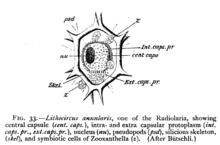Zooxanthellae
Zooxanthellae are single-celled dinoflagellates that are able to live in symbiosis with marine invertebrates such as corals, jellyfish, and sea anemones. Most known zooxanthellae are in the genus Symbiodinium but some are known from the genus Amphidinium, and other taxa, as yet unidentified, may have similar endosymbiont affinities.[1] In freshwater habitats, similar endosymbionts are known as zoochlorellae.[2]

Zooxanthellae are photosynthetic organisms, which contain chlorophyll a and chlorophyll c, as well as the dinoflagellate pigments peridinin and diadinoxanthin. These provide the yellowish and brownish colours typical of many of the host species.[1] During the day, they provide their host with the organic carbon products of photosynthesis, sometimes providing up to 90% of their host's energy needs for metabolism, growth and reproduction. In return, they receive nutrients, carbon dioxide, and an elevated position with access to sunshine.[3][4]
Dinoflagellates are microscopic single-celled planktonic organisms that used to be classified as algae but are now considered to be in a large and diverse group known as Alveolata. They can be free-living or can be present in large number in the tissues of a host. The motile, mastigote stage in the water column has two flagella and a characteristic method of swimming, while inside a host it metamorphoses into a spherical, non-motile, coccoid stage without any flagella.
Zooxanthellae are particularly associated with reef-building corals but they also inhabit other invertebrates and protists; their hosts include many sea anemones, jellyfish, nudibranchs, certain bivalve molluscs like the giant clam Tridacna, sponges and flatworms as well as some species of radiolarians and foraminiferans.[5] Many different species of zooxanthellae are present in host organisms, each species with its own adaptive capabilities and degree of tolerance of varying environmental factors.[1]

A juvenile organism or newly established colony can acquire its zooxanthellae via sexual reproduction or directly from the environment. The egg from which the individual developed may have already been infected by zooxanthellae at the time of fertilisation, or cells of the symbiont may have been transferred from the mother in a period during which the larva was brooded by its parent. Alternatively, the new individual may acquire the zooxanthellae direct from sea water in which the dinoflagellates freely live at some stages of their life cycle. Some stony corals use chemotaxis, with infection occurring as a result of the emission by the coral of a chemical attractant. Infection may also occur after ingestion of infected faecal matter by the host, or of prey that already houses the symbionts. Such indirect acquisition can result in the new host being infected by a species of zooxanthella different from that present in its parent.[1]
Coral bleaching occurs when corals expel their zooxanthellae in reaction to environmental stress.[6] This process is believed to be a defense mechanism to reduce the short-term metabolic burden on the coral.[7] A coral that has expelled its zooxanthellae may be recolonised by another species that is better adapted to the stressors present in the environment. However there is a risk that the coral will die before that can occur.[4]
References
- 1 2 3 4 Birkeland, Charles (1997). Life and Death of Coral Reefs. Springer Science & Business Media. pp. 98–99. ISBN 978-0-412-03541-8.
- ↑ Hoek, Christiaan; Mann, David; Jahns, H. M. (1995). Algae: An Introduction to Phycology. Cambridge University Press. p. 278. ISBN 978-0-521-31687-3.
- ↑ Ruppert, Edward E.; Fox, Richard, S.; Barnes, Robert D. (2004). Invertebrate Zoology, 7th edition. Cengage Learning. p. 122. ISBN 978-81-315-0104-7.
- 1 2 Lohr, Jayme; Munn, Colin B.; Wilson1, William H. (2007). "Characterization of a Latent Virus-Like Infection of Symbiotic Zooxanthellae". Applied and Environmental Microbiology. 73 (9): 2976–2981. doi:10.1128/AEM.02449-06.
- ↑ Trench, R.K. (1997). "Diversity of symbiotic dinoflagellates and the evolution of microalgal-invertebrate symbioses". In Lessios, H.A.; MacIntyre, I.G. Proceedings of the eighth International Coral Reef Symposium, Panama, June 24–29, 1996. 2. Balboa, Panama: Smithsonian Tropical Research Institute. pp. 1275–86. OCLC 833272061.
- ↑ Dove SG, Hoegh-Guldberg O (2006). "Coral bleaching can be caused by stress. The cell physiology of coral bleaching". In Ove Hoegh-Guldberg, Jonathan T. Phinney, William Skirving, Joanie Kleypas. Coral Reefs and Climate Change: Science and Management. [Washington]: American Geophysical Union. pp. 1–18. ISBN 0-87590-359-2.
- ↑ Bowen, James (2015). The coral reef era: from discovery to decline: a history of scientific investigation from 1600 to the Anthropocene epoch. Springer International Publishing. ISBN 978-3-319-07478-8. doi:10.1007/978-3-319-07479-5.